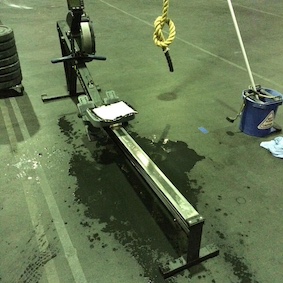Year of the Engine Program Review - Year 1
Please note this is a review of the 1st year. Go here for the 2nd year.
tl;dr
I completed the first year of The Gains Lab Year of the Engine capacity program by Matt Wiebke. The results of each workout were recorded. Tests were performed during the program and after it was completed which showed significant improvement in capacity, workout execution and consistency of effort across a range of workouts. I recommend the program if you wish to improve your cardiovascular capacity.
About this review
Whilst going through the Year of the Engine program, I would occasionally reflect on my results to determine how I was progressing. I realised I had accumulated a significant amount of data which is collated into this review. My hope is to give people who are interested in the program concrete information in the way of results, as well as subjective information in the way of review and opinion.
A box like this describes a decision, experience or an observation that I made while on the program.
Disclosure
I have trained with The Gains Lab previously, having completed five months of the Total Domination program about 9 months prior to starting Year of the Engine. I have also done some behind-the-scenes work on The Gains Lab website in exchange for a reduced rate on this program.
This review is unsolicited.
Approval
Prior to publishing, this review was sent to Matt Wiebke from The Gains Lab seeking:
- Approval to show some specific workouts from the program;
- Comment on accuracy of how I describe the program.
Workout obfuscation
For purposes of discussion, selected workouts that comprise the program are described in detail in this review. All other workout descriptions are obfuscated to protect the content of the program. This obfuscation is described in more detail below.
Data
The results and graphs presented in this review come directly from data collected throughout the program. Stroke data information for specific rower and SkiErg workouts were sourced from my account on the Concept2 Logbook; links are provided where referenced.
Program Overview
A broad overview of the program is provided below. More detail is available on The Gains Lab Engine page. Matt also gives a good summary on this /r/crossfit thread.
Phases
The program has four phases. Each phase builds on the work from the previous phase, necessitating completing each one before starting the next.
| Phase | Focus | Months | Workout types |
|---|---|---|---|
| Engine Builder | Imbalance correction | 1, 2, 3 | Intervals, Endurance, Time trials |
| Polarisation | Improve oxidative capacity | 4, 5, 6 | Intervals, Endurance |
| Differentiation | Increase speed and power | 7, 8, 9 | Intervals, Endurance, Polarisation, Time trials |
| FLUX | Zero-rest intervals | 10, 11, 12 | Intervals, Endurance, Polarisation, FLUX |
Tracks
The Polarisation and Differentiation phases (months 4 to 9) are split in two tracks that you can choose from:
- Pure capacity ergometer only track. Workouts are apparatus only.
- Metabolic Conditioning (MetCon) track. Workouts utilise multi-movement patterns with varying equipment (eg. barbells, dumbbells, wallballs, jump rope, etc)
It is possible to mix and match between tracks, and change tracks between phases.
Workouts
Workouts were received via email each month as a single .pdf file. Each file contains four weeks of workouts, each week having five workouts to complete.
An exception to this format is the first month of the program, in which the fifth workout in each week is optional.
Workout types
Each workout type is described below. As mentioned above, only a select number of workouts are described in full in this document; all other workout descriptions are obfuscated according to the rules below.
| Workout Type | Description | Example workout | Obfuscation | Described here as |
|---|---|---|---|---|
| Interval | Alternating rounds of work time or distance, and rest time. Broken up into speed/threshold, anaerobic and max aerobic power sub-types. | 4x500m/1:00r | Cumulative work time and rest time. | 2k/3:00r |
| Endurance | Total duration of work time at consistent pace. | 52:00 consistent pace | No change. | 52:00 |
| MetCon | Exercises to be done for time, or for rounds and repetitions. | For time
|
Not used in this review. | Not used in this review. |
| Time trials | Total duration of work time at or beyond a competition pace. | 10:00.0 Time Trial | No change. | 10:00.0 |
| Polarisation | Total duration of work time, with repeated intervals of maximum effort for short durations. | 24:00 at endurance pace with max effort for 0:07 at minutes 5, 10, 15 and 20 | Total work time. | 24:00 |
| FLUX | Alternating rounds of work at endurance pace and above endurance pace. | 12 rounds of:
|
Total work time. | 36:00 |
Equipment
Year of the Engine uses ergometers. The program as supplied gives options for:
- Rowing on the Concept2 indoor rowing machine or similar;
- Skiing on the Concept2 SkiErg or similar;
- Biking on the Assault Air Bike, Rogue Echo Bike, Concept2 BikeErg, Schwinn AirDyne or similar; and
- Running.
Each workout can be completed with a different apparatus. Scalings are supplied. The program strongly suggests which apparatus are not suitable for certain workouts.
Additional Training
The program can be run as standalone or in addition to other training. Integration with other training is left to the athlete to manage.
Methodology
The subject
- Male, late 40s, 182cm, 100kg.
- Married, kids, desk-bound work. Normal day-to-day western-lifestyle stresses.
- Basketball, mountain biking, road cycling, snowboarding, martial arts prior to 2012. CrossFit and running about after the kids since 2012.
- Non-competitive exerciser. Training to stay healthy.
- About an hour available to train each day.
- Meat-and-three-veg diet. Dad-bod well in progress. Probably too many Tim Tams.
- Plasma donor, every two weeks (interesting observation).
Tracks
As previously noted, there are two tracks you can choose from during phases 2 and 3: pure capacity or metabolic conditioning.
I chose pure capacity. All references to workouts in this review will only be for this track, and not for the MetCon track.
Scheduling
The program places no restriction on what days workouts are to occur, only that each weeks' workouts are to be completed before moving to the next week.
The program deliberately allows you to move workouts around during the week in order to fit in with other training and life.
I tried to do shorter workouts (intervals, time trials) during the week, and longer workouts (endurance, polarisation, flux) on the weekend to fit in with life.
I chose not to explicitly schedule rest days, taking a day off when tired or if life conflicted with training.
Some workouts were shifted between weeks due to life.
My workouts were predominantly done between 05:00 and 09:00, and prior to first meal of the day.
Additional Training
During phases 2 and 3, I was able to fit in strength training of less than 45 minutes, between two and three times per week. Exercises rotated between various combinations of back squat, press, deadlift, front squat, bench press and pull-ups. Maintenance weights only; loads did not increase. These workouts were done immediately before the scheduled Year of the Engine workout for that day.
I completed perhaps a half-dozen MetCon workouts while doing the program, as part of social events and not as part of training. I did not do a Year of the Engine workout on these days due to lack of time.
All other exercise was incidental. This included road and mountain bike riding, an occasional swimming session, and playing with my kids.
Equipment
I chose:
| Workout type | Apparatus | Rationale |
|---|---|---|
| Interval | Rower SkiErg | Concept2 provide the mobile application ErgData which records entire workouts performed on their ergometers. This includes per-stroke data, which came in useful for examining interval consistency. |
| Time trials | Rower AirDyne | Time trials in the program are specified for the rower and air bike. |
| Endurance Polarisation FLUX |
AirDyne | I find longer sessions more comfortable and tolerable on the bike than on rower or SkiErg. |
| Schwinn AirDyne6 | Concept2 SkiErg | Concept2 Rower |
|---|---|---|
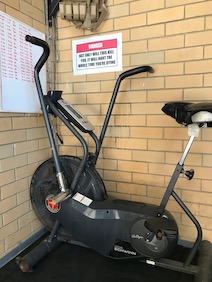 |
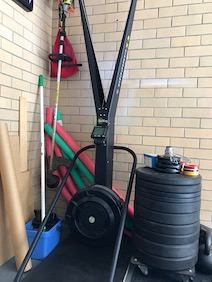 |
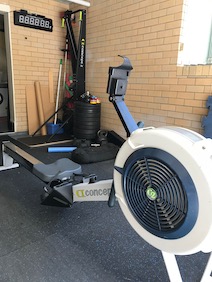 |
Recording results
The .pdf supplied each month specifies what to record for each workout, with space available to write results. Matt suggests printing out each sheet and recording directly on the sheet.
On the rower and SkiErg I used Concept2's ErgData to record each session, which were then uploaded to the Concept2 Logbook. Workout information, including stroke data, was extracted using the Concept2 developer API).
The AirDyne lacks automated recording, so I took a photo of the monitor at the end of each workout and tabled the results in a spreadsheet.
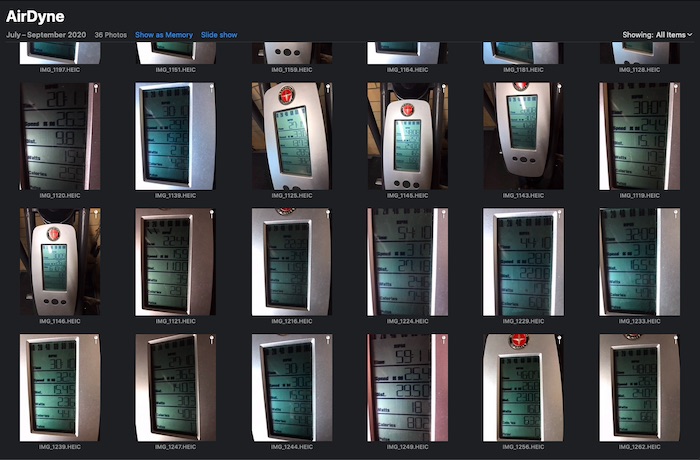
A sample of the air bike post-workout gallery.
Execution
I started the program on Monday 16th September 2019, and finished on Sunday 13th September, 2020.
Workouts, and their phases, were completed as below.
Objective results
The following workouts are presented as evidence of performance changes both during and after year one of the Year of the Engine program. The results are mine alone (n = 1).
The workouts have been chosen as they are either de-facto tests of fitness, have notoriety within the fitness community, or the process of doing the workout and investigating the data yielded interesting results.
10:00.0 Air Bike time trial
The 10:00.0 air bike test is scheduled three times in phase 1 (weeks 4, 8, 12) and three times in phase 3 (weeks 25, 29, 33). These tests are not placed ouside of the workout schedule; they are included as part of training. No special preparation was taken for these tests.
There was 11.2% increase in calories recorded by the AirDyne monitor between the first and last test.
There's not much in the way of exposition for this test. The goal each time was to increase number of calories from the previous test, and to be as consistent as possible throughout the test.
The AirDyne doesn't have any way of recording intra-workout metrics; it would have been nice to see where pace changes occurred in order to develop a better approach than “go fast and hang on”.
Couldn't quite get to 200cals in the last test.
20:00.0 rower time trial
The 20:00.0 rower test is scheduled three times in phase 3 (weeks 27, 31, 35). These tests are not placed outside of the workout schedule; they are included as part of training. No special preparation was taken for these tests.
Logbook data: Attempt 1 Attempt 2 Attempt 3
There was 2.8% increase in calories recorded by the rower monitor between the first and last test. Pace increased by 1.4s/500m between tests 1 and 2, but only 0.1s/500m between tests 2 and 3.
Test 3 felt very poor. I was unwell at the end of the previous week and was most likely still recovering. While faster than test 1, it was equal to test 2. I bonked with less than 4 minutes to go, whereas pace was held throughout tests 1 and 2. We can see this by examining the pace for each test:
Attempts at the 20:00.0 rower time trial prior to the Year of the Engine are shown below, along with the three tests from above. Year of the Engine programming period is shaded.
24x0:30/0:30r rower
24x0:30/0:30r (24 intervals of 30 seconds work, 30 seconds rest) is scheduled once each in phases 1, 3 and 4 (weeks 11, 27, 45). I completed the 1st and 3rd workout on the rower, and the second on the SkiErg. Here we will examine the rower workouts.
A cursory glance indicates a worse result at attempt 2. A closer examination is required.
| 24x0:30/0:30r | Attempt 1 | Attempt 2 | Variance |
|---|---|---|---|
| Date | 24th November, 2019 | 21st August, 2020 | +8 months, 28 days |
| Average Pace (/500m) | 1:39.3 | 1:39.1 | -0:00.2 |
| Distance | 3,624m | 3,631m | +7m |
| Calories | 296 calories | 294 calories | -2 calories |
| Stroke count | 364 strokes | 348 strokes | -16 strokes |
| Stroke rate | 29 spm | 28 spm | -1 spm |
| RPE | 8-9 | 7-8 | -1 point |
| Concept2 logbook | Attempt 1 | Attempt 2 | N/A |
Distance and pace barely improved. Calories were lower in attempt 2, again marginally. Stroke rate per interval was lower, resulting in fewer total strokes across the workout. There were 9 months between attempts.
- Was attempt 2 an improvement over attempt 1?
- If so, why wasn't it bigger, since 9 months of training had elapsed?
Let's start with stroke count, as it sticks out the most. Attempt 2 recorded 16 fewer strokes. We can see where this happened by looking at the number of strokes per interval:
Attempt 2 had one less stroke in 16 of the 24 intervals compared to the attempt 1. We know the attempt 2 covered further distance, so we can make the presumption that distance per stroke increased.
What is the impact of one fewer stroke per interval over the same distance? We can examine distance each interval, and graph by stroke:
As attempt 2 drops strokes compared to attempt 1, it's graph “shifts left”, until it is 16 strokes ahead of attempt 1. Attempt 2 has completed the same distance as attempt 1, but with fewer strokes. And the 16 strokes difference matches our variance previously tabled.
So how far apart, in distance, are the attempts each interval? Using attempt 1 as a baseline, we can graph attempt 2's increase or decrease in distance per interval:
We can see that compared to attempt 1, attempt 2 started out with a large lead in interval 1, continued building through to interval 15, then recorded reduced distance in intervals 17 to 24. We can visualise the “lead” by accumulating this difference each interval:
By interval 15, attempt 2 has accumulated a lead of 29m over attempt 1. This gain is eroded as the workout continues. The distance remaining in attempt 2's bank at the end of the last interval is 7m, which matches our variance previously tabled.
However, we have yet to determine why the distance discrepancy appears. Was attempt 1 slow opening then sped up? Did attempt 2 do the opposite? Let's look at pace in each interval.
The points representing pace for attempt 1 appear to vary more than attempt 2. We can look at the distribution of pace for both attempts to verify:
By grouping the intervals' pace from each attempt, we can see that the range of attempt 2 is tighter than attempt 1, demonstrating the principle of maximising the average, minimising the range:
Attempt 2 held a more consistent pace per interval than attempt 1.
One last thing to look at is power per stroke:
The distribution balances out the spikes:
Attempt 2 generated marginally more power per stroke than attempt 1, with a slightly improved consistency.
Summing up: objectively we have:
- Attempt 2 used fewer strokes to go further.
- Attempt 2 had a lower calorie cost.
- Attempt 2 showed more consistency in pace.
- Attempt 2 showed more power per stroke.
Subjectively, we have:
- Attempt 2 RPE improved.
We can summarise the above points by saying attempt 2 was more efficiently executed than attempt 1. Attempt 2 yielded a marginally better result than attempt 1 at a lower energy cost, and demonstrated improved consistency of effort.
But this conclusion does nothing to explain the lack of significant improvement given the 9 months of training between attempts. Why?
Occam's razor: I screwed up.
When repeating workouts, I check my previous result, consider how I'm feeling, predict how much faster I could complete the work and use that as my goal. When I checked my history, I accidently looked up 20x0:30/0:30r instead of 24x0:30/0:30r).
20x0:30/0:30r had a pace of 1:40.5. It was done 6 weeks prior to attempt 1 of 24x0:30/0:30r.
For attempt 2, I conservatively chose 1:39.5, not realising I should have been aiming for at least 1:38.3.
In the end: attempt 2 had a pace of 1:39.1, an improvement on 20x0:30/0:30r, an improvement on 24x0:30/0:30r, faster than the goal pace set at the start of the workout, and completed with a lowered RPE.
While the on-paper gain was negligible, we could conclude that there was improvement between attempts, but instead of bigger / faster / stronger, the gain was a demonstrated increase in ability to hold a consistent pace.
And a lesson: when repeating workouts, check previous results twice.
3x2,000m/3:00r rower
3x2,000m/3:00r rower (3 intervals of 2,000m with 3:00 rest in between) is scheduled once in phase 1 (week 12). Attempt 2 was done after the end of the program. Year of the Engine programming period is shaded.
| 3x2,000m/3:00r | Attempt 1 | Attempt 2 | Variance |
|---|---|---|---|
| Date | 7th December, 2019 | 15th September, 2020 | +9 months, 8 days |
| Average Pace (/500m) | 1:53.5 | 1:51.7 | -0:01.8 |
| Time | 22:42.6 | 22:20.6 | -0:22.0 |
| Calories | 423 calories | 433 calories | +10 calories |
| Stroke count | 588 strokes | 542 strokes | -46 strokes |
| Stroke rate | 26 spm | 24 spm | -2 spm |
| RPE | 8-9 | 7-9 | -1 |
| Concept2 logbook | Attempt 1 data | Attempt 2 data | N/A |
Let's compare interval pace. The fastest interval in attempt 1 was slower than the slowest interval in attempt 2; the fastest interval in attempt 2 beat the fastest in attempt 1 by 11 seconds:
Comparing each interval by pace shows more consistency and a bigger finish in attempt 2:
This is backed up by examining the normal distribution of pace for each interval. The lack of consistency in the third interval of attempt 2 is because of the sprint finish, much faster than attempt 1 but with a larger range:
The stroke rate of attempt 2 was lower than attempt 1 across all intervals (excluding the sprint finish). This is reflected in our tabled data of 46 fewer strokes over the whole workout, and 2 fewer strokes per minute:
Attempt 2 felt no more difficult than attempt 1, but the result was a big increase in pace and consistency. I feel that this result is much more important than the time trials, as it demonstrates a skill increase in managing pace, stroke rate, power delivery and recovery, and not just pure grunt increase.
It would be interesting to try this test again with a higher stroke rate in the last interval.
Acid Bath
“Acid Bath” was the 6th individual workout programmed for the 2018 Dubai CrossFit Championship. It is one variant of the Concept2 Ergathlon Super Sprint:
For time:
- 500m Concept2 SkiErg
- 500m Concept2 rower
- 1000m Concept2 BikeErg
7:00 time cap (women)
6:00 time cap (men)
The workout took me 5:18. Compared to some others:
Roman Khrennikov and Mat Fraser's approximate times taken from the clock on the event video. Marston Sawyers and Heber Canon's times taken from The Buttery Bros Acid Bath in Mat Fraser's Garage video, with some extrapolation due to not having a continually visible running clock.
This workout isn't part of the program, but I thought it would be fun to do an ergometer-based test that has been used in competition and on (community) social media to compare times.
I used an AirDyne6 instead of a BikeErg. So while the graph above is as accurate as possible for times, the bikes will not accumulate metres in the same fashion so my placing is optimisitic. Again, just for fun.
Video of my attempt, SkiErg stroke data and rower stroke data.
Subjective observations
Workout approach
My approach to workouts has changed. The higher-than-comfortable sustained "steady state" work from the program has changed my perception of the usefulness of fly-and-die. I now temper opening rounds in a workout aiming for 100% consistency instead of going too hard early and trying to recover on the run.
The phenomenom of fast finishes
While completing phase 1, I started to notice that many of my interval results were following a similar pattern: the last interval was usually at a higher pace than the previous intervals, with a kick toward the end, like below:
Sometimes I couldn't hold the kick all the way to the end of the interval, but inexplicibly, my pace stayed above the average for that interval, like below:
It's not negative splits, I didn't feel that I sandbagged these workouts, and I had chosen paces that I knew I could hold across all intervals without going too fast nor slow.
Other athletes doing Year of the Engine have shown this as well; some examples here, here, here and here.
This is probably due to being too conservative in opening intervals. I guess with more experience it would be possible to choose opening paces better, and close the gap between them and the last interval.
RPE
The rating of perceived exertion scale (RPE) is a measure of perceived exertion of a physical activity. The biggest change I feel related to RPE is being able to hold consistent pace on the air bike. A year ago, holding 29-30kph on the AirDyne for 20:00 was my limit, and rated it RPE 10. I am now able to hold the same pace for 60:00 at RPE 7.
Technique changes
My “skill” level on the air bike has significantly improved. The cycling motion is now more refined with significantly less lateral movement. In particular, bobbing of the head left and right has vanished, with torso remaining much more still and upright. These improvements feel like I'm putting more energy into the bike rather than away from it.
The SkiErg remains a mystery.
Donating plasma
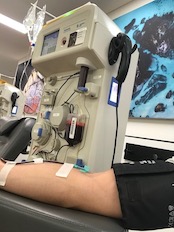
Part of a post I made on /r/crossfit in early 2020:
Up until end of last year, I would donate plasma on a Saturday morning after a workout, then rest until late Sunday afternoon to do my next workout - averaging between 30 and 33 hours of rest.
Schedule change at start of the year meant donating on Sunday morning, resting until Monday morning workout - averaging between 23 to 25 hours of rest. So a decrease of around 7 hours.
Since the schedule change, I've noticed significant drop offs in performance in that first workout after donating. The sensation during the workout isn't of a fatigue brick, huge drop in energy or I-think-I'm-dying; it's more of a "I can't sustain this pace even though I should be able to," and so I slow to make it through without stopping. Subsequent workouts, spaced at 24-hour periods, are fine.
All other things being equal, the altered rest period seems to affect me significantly, with age no doubt playing a part too. Some random Googling turned up this document from NASM regarding effects of blood, plasma and platelet donations on exercise. There are some papers listed in the reference section which were very interesting support material.
Reflection
What I believe I got right
- Followed the program. Adherence to the program was initially difficult, but once a proper schedule was established, and an understanding of the amount of effort required to complete the first couple of months was achieved, it became much easier to follow the program.
- Moved workouts around inside the training week. In order to fit the workouts into my schedule, it was necessary to move them within the week rather than strictly follow the program. This is provided for in the program. Had I tried to do the workouts in order as written, it would have been nearly impossible to fit into my schedule.
- Rested by feel, not by schedule. I explicitly chose not schedule rest days into my week, instead opting to rest when tired or when non-training events prevented training. This worked well; some weeks I would do 6 days in a row, starting the next weeks' training early. Other weeks life would get in the way and I might miss a few days in a row. I feel if I had tried to stick hard to a schedule, I would have missed a lot more training days.
What I know got wrong
- Insufficient attention to recovery. During phase 2, I started getting a lot of lower back, glute and hip flexor pain. This was probably caused by an increase of time on the AirDyne during this phase. I was not used to sitting on a stationary bike for extended periods and had poor form. The rower was the primary apparatus on the previous phase and did not contribute to any symptoms. I added a stretching plan into my schedule and gradually the pain subsided.
- Overly optimistic endurance pace selection. Phase 2 requires selection
of an endurance pace, which is held as a minimum pace during
Endurance, Polarisation and FLUX workouts. It is described by Matt as:
Your friend enters the gym and walks over to say hello. You have sufficient oxygen such that you can say a quick hello, ask him politely how it's going, but cannot carry on a conversation of any length.
and:Pace for endurance days: 7/10 rpe, 70-75% max HR, so as long as you’re around there, it’s good work.
My initial endurance pace estimate was too fast, and as workouts became longer, it was more difficult to hold onto pace. I took too many workouts to realise this was the problem. However once the penny dropped, I used the next couple of Polarisation workouts to narrow down the pace to better match Matt's description.
What I think I would change
-
Spread workouts across more apparatus. Throughout phases 3 and 4 I worked mainly on the AirDyne, only doing intervals on the rower and rarely the SkiErg. While the main reasons for this was comfort on longer sessions, I suspect balancing out work across apparatus would be a more beneficial approach, giving more resilience to longer workouts on the rower and SkiErg.
-
Include some workouts from the MetCon track. I chose to follow just the ergometer track, foregoing any weightlifting and gymnastics movements. No doubt this contributed to the feeling of grind. Interspersing non-ergometer workouts throught the program would introduce more variance and reduce that grindy feeling.
-
Upgrade the air bike. I used the Schwinn AirDyne 6 as my air bike. Aside from showing its age, it has no method to accurately track effort in a workout and does not recall past workouts. I would like to be able to get performance data as per the Concept2 rower and SkiErg, some of which is visualised in the graphs in this review. Perhaps a Concept2 BikeErg is on the horizon.
Responses to reddit questions
About a month prior to finishing year one of Year of the Engine, I posted some observations and the 10:00.0 air bike results on /r/crossfit. There were a couple of questions.
2k times
did you time-trial a 2k row before and after?
No, but I do have data from 2ks prior. As /u/username45031 pointed out:
It'll improve your 2k but it’s not designed for that kind of thing; the Pete plan is focused on improving erg scores.
I chose not to do a 2k after the program was done, as the 10:00.0 air bike time trial is close enough to a 2k row as a threshold test, and we already looked at that.
Instead, I repeated 3x2,000m/3:00r as it occurred fairly early in the program, is based on 2k for which there is a lot of data, and would provide a good insight into performance changes. For comparison, below are my previous single 2k times along with each interval of both 3x2,000m/3:00r attempts. Year of the Engine programming period is shaded in red.
The area shaded in green in the above graph is while I was doing another Gains Lab program called Total Domination, which uses Year of the Engine for it's conditioning component. I attended a 2k rowing competition approximately 8 weeks into this program and rowed 6:51.8, a 6-second PB. No specific 2k training was undertaken prior to competition.
Oh, and the real reason I didn't test 2k before or after Year of the Engine: **2k tests really hurt**.
Biological markers
Curious - since you measured your power output and that correlates with bodyweight, did you track your bodyweight as well?
I record bodyweight, haemoglobin count, blood pressure and resting heart rate as part of regular plasma donation protocol and not as specific training metrics:
Blood pressure increased from March, 2020 to June, 2020. This correlates strongly to the introduction of restrictions related to employment, travel and social interactions introduced by the Australian state and federal governments in an effort to curb the spread of COVID-19. The stresses caused during this period, personally, professionally and familially, are reflected in higher than normal blood pressure readings.
Bodyweight, resting heart rate and haemoglobin count remained level:
Program review
From here on is entirely my opinion. Data is from my results. Feel free to disagree.
Program Structure
Year of the Engine is simply structured and easy to follow:
- 5 workouts each week.
- 4 weeks' worth of workouts provided at the start of the training month.
- 3 months per phase.
- 4 phases over the entire of year one.
Adjustments available to the athlete are similarly simple:
- Move workouts around in a week as you see fit.
- Complete all workouts in a week before moving to the next.
- Complete one phase before moving to the next.
Each phase has instructions which are provided with the first month of that phase. Each workout is described without superfluous verbage. There is virtually no room for over-interpretation.
Program flexibility
While highly structured, the program does provide some flexibility:
- It can be used as a standalone conditioning program;
- It can be scheduled to fit in with an existing training schedule;
- Workouts fit a range of apparatus.
The program assumes knowledge in how to operate your chosen apparatuses; it provides no instruction here.
If you are seeking a program that you can tailor beyond the above, then you may be disappointed.
Program requirements
While the program is geared towards having access to a rowing machine and an air bike, other forms of exercise can be substituted. SkiErg has been mentioned, and there are scalings provided for running. Matt has mentioned in the past athletes choosing swimming for some workouts.
If you have access to a gym, or are able to run, you will have access to at least one form of activity suited to the program.
Workout description
Each workout is clear, short, simply stated and unambiguous. 'nuff said.
There is no warm-up or warm-down specified.
Workout intensity
The intensity of each phase is described in the instructions received at the start of that phase. For example, part of the FLUX instructions:
If you're unable to hit the suggested FLUX pace, that's OK. Go as high as you can, provided that you can sustain endurance pace between FLUX intervals.
Similarly to the workout description, instructions on intensity are clear and unambiguous.
Workout target metric
Note: this observation is based on the pure capacity track I followed, not the MetCon track.
Of the 240 workouts in the program, only 8 specify a set distance as the workout target metric. That is, 8 workouts are “for time”, meaning “complete the distance while minimising the amount of time working”.
The other 232 workouts specify a set time as the metric. These workouts are “for distance”, as the goal is to maintain or maximise distance in a given time frame. High sustainable effort yields reward here.
“For distance” workouts specify the workout duration in the description, so scheduling is easy. “For time” workouts are less simple to schedule, as the duration of the workout relies entirely on how fast you can complete the work.
“For distance” workouts are also easier to scale across not only apparatus, but also athletes. A 3:00.0 effort requires no scaling of time between a rower, SkiErg or air bike. Similarly, 3:00.0 for a novice and 3:00.0 for an elite are the same domain; only the skill level on the apparatus and the intensity brought by the athlete differ.
I found “for distance” workouts yielded much more consistent results than past attempts at other programs which focused on minimising time, even when working at higher than “comfortable” paces.
Longer workouts, such as Endurance, warn against unbalanced effort:
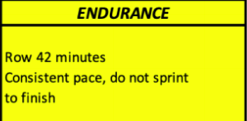
I tempered the urge to sprint with the knowledge that the time domain is fixed: sprinting too early would result in limping home, yielding an inconsistent pace. Not what the workout is asking for.
There is definitely the right time and place in the program to sprint: the speed and threshold Interval workouts require effort at and above race pace, time trials by definition are sprints, and the Polarisation and FLUX workouts will truly test your mettle with sustained, above-“comfortable” speeds with even faster bursts.
Conditioning can be considered the result of repeated, sustained effort over time. More information here.
Time commitment
Note: this observation is based on the pure capacity track I followed, not the the MetCon track.
The length of a workout depends on the workout type and workout specifics for that day.
Daily workout duration changes over the course of the program. Time trials were 20:00 or less, Intervals and FLUX remained around 30:00, Endurance and Polarisation workouts gradually increased, capping at an hour.
Constantly varied?
Note: this observation is based on the pure capacity track I followed, not the the MetCon track.
Each workout is variation on the theme of the workout type: Intervals are interleaved periods of work and rest, Endurance is long “steady state”, Polarisation is shorter-length endurance but with bursts of max effort, and so on. As such, while each workout changes in it's fine details, the theme of each type of workout remains consistent. We can chart workout type across the program to see how they are spread:
The last workout type from the previous week may start the new week off. Overall the workout types are spread well, and as mentioned previously, the athlete may move them around within a workout week to suit.
Interval workouts dominate phase 1. Phase 2 reduces Intervals, balancing them with the introduction of Polarisation and steady Endurance work. Phase 3 maintains Intervals, reduces Polarisation and slighly increases Endurance. The program ends in phase 4 with emphasis on FLUX workouts.
Apparatus choice is a variable in the program. Here are my chosen apparatus against workout duration:
At times the program felt grindy - a lot of time, a lot of sweat, with the only difference between like-themed workouts being a small detail. The time trials are in phases 1 and 3, so at times it's difficult to gauge how you are progressing in phases 2 and 4.
But there is magic here. Or rather, intent. A closer examination of individual workouts in each workout type across an entire phase show a consistent increase in the variables of duration, rest, and intensity. Not huge leaps and bounds, but a regular, steady increase. All these small increases put together create a tidy, measured and most importantly achievable progression in intensity.
I found phase 2, when Polarisation was introduced, to be the most physically difficult. The intensity increased, workout length increased, and while I felt like I was improving I had no hard data to back it up. This is in contrast to phase 1, where there were three time trials to gauge progress.
However, after completing phase 2 - and specifically after the time trials in phase 3 - it became overwhelmingly obvious that the grind in phase 2 provided the foundation for results in phase 3 and especially in phase 4.
Is the program on the pure capacity track constantly varied? In the CrossFit sense of “constantly varied”, no. Yet this is on purpose, and the reasoning why is well worth the read.
Mental fortitude
The length of time that you spend each day on the program will test your ability to “embrace the suck.” Whether shorter Intervals at high number of rounds, or longer Endurance workouts at a sustained pace with bursts, all of the workouts require a mental commitment to complete.
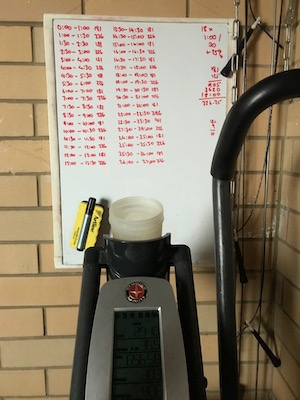 The whiteboard of pain.
The whiteboard of pain.
I found phases 1 and 2 to be the most mentally difficult. Intervals never seemed to end, even knowing how long the workout was going to be. Phase 2 workouts meant a lot more time on the bike than ever before. It was hard being in inside my head with no escape for long periods, grinding away.
I found phase 3 to be less mentally exhausting, as focus shifted toward maintaining sustained output with less (or no) rest for longer periods. Familiarisation with the workouts possibly helped. Could I be getting fitter?
Bizarrely, workouts in phase 4 became less mentally taxing and more mentally challenging. Instead of aiming for survival, the emphasis changed to something like a game - how close to pace I could stay while pushing a bit harder on the max bursts? This phase almost became fun.
Recovery
The program doesn't dictate what recovery should be or when it should occur. Workouts are specified five days per seven day week; it would be safe to assume that the remaining two days would be allocated to recovery, as least from this program.
The apparatus suggested by the program are largely non-impact, reducing the need for the body to absorb significant shocks for extended periods, in turn reducing the amount of soreness and time needed for recovery. Running is the exception; care should be taken when choosing which workouts to run, and how best to recover.
At no time was I sore, or unable to do a workout due to a previous session. On a few occasions I did six days in a row with no ill-effect. This will of course vary depending on your training and non-training loads.
Assistance
Matt is very responsive to questions about the program, and will explain concepts or workouts if there is any confusion. He is active on Instagram and the /r/crossfit subreddit.
Community assistance is available via a Facebook group for people doing the program.
Summary
Year of the Engine is a program designed to improve cardiovascular capacity. I completed the first year, following the instructions as provided, and demonstrated significant improvements in capacity and consistency across interval, endurance and burst workout types.
The program is administered simply. A monthly email provides workouts for the month. Instructions are clear and easy to follow. The rationale and reasoning behind the program are public and easy to digest.
The program does not discriminate against the novice, intermediate or advanced athlete. Workouts are overwhelmingly fixed duration, so intensity is left to the athlete to determine, guided by instruction.
Support is readily available from the program author. A group to discuss the program is available for those doing the program.
Recommendation
As a beyond-novice-but-not-a-fully-intermediate exerciser, with limited time to train and regular day-to-day stresses and interruptions, I found the program readily accessible, schedule-forgiving and physically and mentally challenging. And I did get gains, as demonstrated by my results.
I feel novices would benefit greatly from this program as it has a very simple structure, is well documented and unambiguous. Get familiar with the apparatus first and make time for recovery.
Intermediate athletes would discover, particularly in phase 1, where the holes in their capacity are. The remainder of the program will serve to fill those holes.
Advanced and elites would be pushed beyond their limits. Phases 2 and 3 would be an opportunity to drastically improve their mental game.
I thoroughly enjoyed year one of Year of the Engine.
